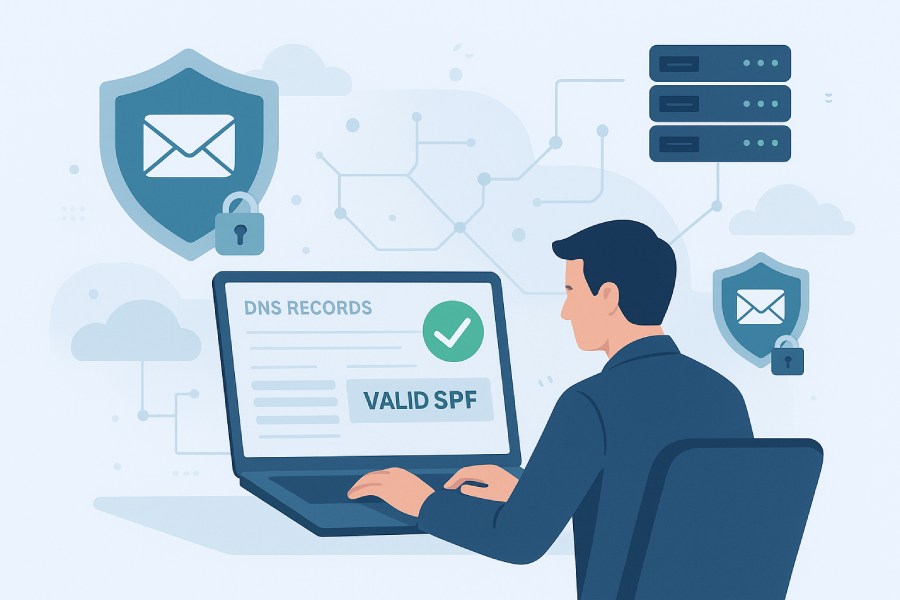An SPF record (Sender Policy Framework) is a crucial piece of your domain’s DNS settings that defines which mail servers are authorized to send email on behalf of your domain. Every domain owner should understand that an SPF record is more than a simple DNS entry—it’s a cornerstone of effective email authentication and is essential for protecting your brand and maintaining email deliverability.
The SPF record itself is published in the DNS as a txt record type, typically beginning with the version string `v=spf1` to indicate SPF version 1 (the only version defined in the SPF RFC specification). The required SPF format uses various SPF mechanisms—such as the a mechanism, mx mechanism, include mechanism, ptr mechanism, exists mechanism, ip4 mechanism, and ip6 mechanism—in combination with SPF qualifiers and SPF modifiers, to explicitly outline which outbound mailers are permitted to send for the domain. For example, a basic spf record example might look like:
v=spf1 a mx include:_spf.google.com -allHere, only servers listed in the domain’s a record, mx record, and Google’s SPF include are permitted. Any other servers will trigger the `-all` SPF all mechanism, which is set to fail unauthorized senders.
SPF DNS lookups, the SPF lookup limit, and correct SPF syntax are vital for proper dns processing and to avoid spf error states such as spf permerror or spf temperror, which can arise from misconfigurations or excessive DNS queries.
The Role of SPF in Email Authentication
Robust email authentication relies on more than just the SPF record, but it remains a required pillar alongside DKIM (DomainKeys Identified Mail) and DMARC (Domain-based Message Authentication, Reporting & Conformance). An acceptable SPF record enables the smtp receiver to perform SPF evaluation via DNS queries to authenticate the spf sender and identify whether the sending ip address is permitted by the SPF policy.
During SPF evaluation, the receiving mail server runs through the SPF record’s mechanisms and qualifiers in sequence:
- The a mechanism authorizes email from the domain’s primary a record.
- The mx mechanism includes servers listed under the domain’s mx records.
- The ip4 mechanism and ip6 mechanism allow specific IPv4 and IPv6 addresses or cidr prefix ranges.
- The include mechanism delegates authorization to SPF records of third-party services (e.g., SaaS Platforms like mailers.example.com).
- The all mechanism is typically used as the final mechanism to set a default policy for all other sources.
The result of SPF evaluation can be spf pass, spf fail, spf softfail, spf neutral, spf none, spf permerror, or spf temperror—each indicating specific actions for smtp receivers. A spf pass result means the message aligns with the policy (accept action), while a spf fail result indicates the mail should be rejected (reject action). Intermediate results, such as spf softfail result, spf neutral result, and spf none result, result in mark actions where mail might be flagged as suspicious.

SPF alignment, which assesses whether the spf sender domain matches the visible “From” domain in an email, is also required for full DMARC enforcement, further stressing the centrality of a valid SPF record in today’s domain authentication standards.
How SPF Protects Against Email Spoofing and Phishing
Maintaining a valid SPF record is the first line of defense against email spoofing and targeted phishing. Attackers often forge the visible sender address to impersonate a trusted brand or internal user (for example, using ceo@hello.com or invoices@deferrals.domain.com). Without a valid SPF record, spam filters and smtp receivers have little way to verify if these messages genuinely originate from your authorized servers or from a malicious source.
A well-constructed SPF record leverages mechanisms like the spf a mechanism, spf mx mechanism, and spf include mechanism to explicitly permit only trusted outbound mailers while blocking unauthorized sources. Misuse of the spf ptr mechanism is discouraged by the SPF RFC specification due to its unreliability, but the exists mechanism can be powerful for dynamic sender authorization.
The inclusion of the spf all mechanism as `-all` (hard fail) at the end of your SPF record is a key anti-abuse measure, instructing receiving email systems to outright reject emails from non-listed sources. A softfail `~all` or neutral `?all` is less strict, often used during SPF troubleshooting or staged rollouts, but always increases risk.
With a valid SPF record, phishing attempts are dramatically more likely to trigger spf fail, spf softfail, or spf neutral results at the recipient’s gateway, causing emails to be marked, quarantined, or outright rejected, thus protecting both end users and your domain’s reputation.
Consequences of Not Having a Valid SPF Record
A neglected or misconfigured SPF record exposes your domain to significant risks. An absent, malformed, or non-functional SPF record frequently leads to spf none, spf permerror, or spf temperror results during SPF record evaluation. Modern smtp receivers, guided by security best practices and the SPF RFC specification, will treat emails failing SPF authentication with suspicion or outright rejection.
Some key negative impacts include:
- Increased risk of spoofing: Attackers can impersonate your domain to send phishing emails, undermining user trust and causing reputational damage.
- Poor deliverability: Major providers like Gmail and Yahoo rely heavily on SPF pass, SPF alignment, and overall domain authentication in their spam filtering algorithms. Missing or failing SPF drastically increases the chance of legitimate mail landing in the spam folder or being blocked.
- Failed DMARC enforcement: Without a valid SPF record, DMARC policies cannot be enforced properly, rendering your investment in DMARC useless.
- Operational confusion: In cases of tempfail (temperror) or permfail (permerror), legitimate messages may be deferred, bounced, or subject to inconsistent handling.
- Audit and compliance issues: Many industries require proper email authentication as part of mandatory security frameworks.
A spf record example demonstrating a dangerous misconfiguration might be:
v=spf1 +allHere, every sender (regardless of origin) is authorized, making the record worse than omitting SPF entirely. Therefore, following SPF best practices and using trusted SPF tools such as dmarcian, MxToolBox SuperTool, or the SPF Survey tool for spf troubleshooting is essential.

How Major Email Providers Check SPF Records
Leading mailbox providers—including Gmail and Yahoo—rigorously evaluate SPF records for every incoming message to determine authenticity. The process starts with a DNS query for the spf records for domains found in the “Envelope From” address during the SMTP transaction. The smtp receiver performs a dns lookup for the SPF record, parses the listed spf mechanisms, spf qualifiers, and spf modifiers, and checks if the sending server’s ip address matches any of the authorized records.
Key steps in the SPF record evaluation performed by these providers include:
1. SPF Version and Syntax Check
The provider validates the presence of a v=spf1 header and correct SPF syntax. Any deviation prompts an spf permerror result.
2. Mechanism Processing and Lookup Limits
The mail server processes each spf mechanism (including a mechanism, mx mechanism, include mechanism, etc.) in order, performing a dns lookup for each. The evaluation must comply with the SPF lookup limit of 10 DNS resolves per SPF record. Exceeding this limit triggers an spf permerror.
3. Qualifier Matching and Record Result
If the sender’s ip address matches an authorized mechanism, providers issue an spf pass result (accept action). If none match, the server acts based on the final all mechanism—either fail, softfail, neutral, or none. For ambiguous results, mark actions add warning banners or spam labels for recipients.
4. Error Handling
Temporary DNS errors or resource failures will result in spf temperror result, prompting the provider to defer processing or retry delivery. Permanent errors in the record lead to spf permerror result, which can result in mail rejection.
5. Record Monitoring and Feedback
To facilitate ongoing compliance, providers encourage the use of DMARC aggregate reports—collected via monitoring tools such as dmarcian’s Delivery Center—to identify issues with SPF alignment and record evaluation.
Using public spf tools such as MxToolBox SuperTool, SPF Survey, and dmarcian’s SPF analyzer allows domain owners to troubleshoot record issues, verify macro expansion, and test SPF evaluation outcomes before they impact mail flow.
For domains sending via SaaS platforms like mailers.example.com or offsite.domain.com, proper use of the include mechanism, redirect modifier, and exp modifier ensures third-party mailers comply with your SPF policy. Trusted vendors often provide SPF record templates or spf delivery tips to maintain an acceptable spf record and preserve consistent deliverability.
Major email providers enforce stringent SPF authentication and SPF deliverability requirements to protect both senders and recipients in the fight against fraud, ensuring every piece of mail associated with your domain is properly validated and authenticated.
Failure to maintain a valid SPF record, adhere to correct SPF format, observe spf administrative boundaries, and keep within spf lookup states leaves your domain vulnerable to abuse and disrupts critical communication channels. Every domain owner must make SPF monitoring, regular spf troubleshooting, and adherence to SPF best practices a core part of their email security strategy.
Step-by-Step Guide: Creating and Implementing a Valid SPF Record
Configuring a valid SPF record is essential for effective email authentication and protecting your domain. Below is a straightforward guide to help domain owners establish SPF records for domains they manage, following accepted SPF best practices and referencing the latest SPF RFC specification.

1. Determine Authorized Outbound Mailers
Identify the mail servers allowed to send mail on behalf of your domain. This typically includes your organization’s mail server, cloud email services (such as Gmail or SaaS Platform), and any transactional email providers. List all IP addresses, a records, and mx records that need to be included.
2. Construct the SPF Record Syntax
Start with the SPF Version:
Every SPF record begins with the SPF version, typically `v=spf1`.
Add Appropriate SPF Mechanisms and Qualifiers:
Include mechanisms like the spf ip4 mechanism (`ip4:192.0.2.24`), spf ip6 mechanism (`ip6:2001:db8::/32`), spf a mechanism, spf mx mechanism, and spf include mechanism. These refer to A records, MX records, and include records referencing other authorized domains.
Example:
v=spf1 ip4:192.0.2.24 a mx include:mailers.example.com -allHere, `-all` is an spf qualifier indicating a reject action for mail not matching earlier mechanisms (spf fail).
Utilize SPF Modifiers if Needed:
The spf redirect modifier can be used to delegate policy evaluation to another domain. Use the spf exp modifier to provide human-readable explanations for failures.
Example with redirect:
v=spf1 redirect=_spf.hello.com3. Publish the SPF Record as a TXT Record
In your domain’s DNS, create a new txt record at the DNS administrative boundaries for your desired domain or sub-domain, placing your SPF syntax within the value field. Wait for DNS processing propagation to complete so records are visible in DNS query results.
4. Monitor and Adjust
Use spf monitoring and SPF tools such as the SPF Survey tool by dmarcian, MxToolBox’s SuperTool, and the Delivery Center to verify ongoing SPF deliverability and spf record result accuracy.
Common Mistakes in SPF Record Configuration
Despite the seeming simplicity of SPF format, misconfigurations are common. These errors can result in spf temp error, spf permerror, or incorrect spf fail and spf softfail results, impairing email delivery.
Exceeding the SPF Lookup Limit
SPF imposes a strict dns lookup limit of 10. Overuse of the spf include mechanism or spf exists mechanism may cause this limit to be breached, returning a spf permerror result.
SPF troubleshooting tip: Minimize includes and exists mechanisms, and monitor lookup states with SPF tools.
Incorrect Use of Mechanisms
- Improper use of the spf ptr mechanism: The spf ptr mechanism is discouraged and may trigger spf error due to unstable reverse DNS.
- Misplaced ‘all’ Mechanism: The spf all mechanism (`all`, often used as `-all`, `~all`, `?all`) must always appear last. Placing it earlier will cause subsequent mechanisms to be ignored.

The Importance of Keeping Your SPF Record Up-To-Date
As organizations add or remove mail systems, the SPF record must reflect these changes to maintain spf authentication accuracy and email deliverability. Outdated records can allow unauthorized senders to pass SPF evaluation or block legitimate mailers.
Why SPF Record Maintenance Is Critical
- Changing Outbound Mailers: New systems or platforms (like Gmail, Yahoo, or transactional SaaS providers) require updating spf mechanisms and modifiers.
- Retiring Legacy Infrastructure: Removing old a records or mx records from the spf record avoids spf softfail or spf fail results for retired servers.
- Provider Updates: Email service providers may change their sending infrastructure IP addresses or update guidance for spf include mechanisms in their documentation.
- SPF Alignment for DMARC: Keeping your SPF record in sync with sender addresses assists DMARC in enforcing spf alignment, critical for robust domain authentication.
Best Practices for Combined Deployment
- Maintain strict, but not overly rigid, SPF qualifiers (e.g., use `-all` or `~all` judiciously).
- Use the spf all mechanism in conjunction with appropriate fail actions based on your mail flow and DMARC policy.
- Regularly monitor spf evaluation and DMARC aggregate feedback for spf authentication issues or sources triggering spf permerror and spf temperror results.
Case Studies: Real-World Impacts of Invalid or Missing SPF Records
Examining cases from organizations illustrates the critical role of acceptable spf record management.
Case Study 1: Delivery Failures Due to SPF PermError
A marketing agency using offsite.domain.com neglected to update their SPF record after migrating to a new SaaS Platform provider. Due to excessive spf include mechanisms and a breach of the SPF lookup limit, all transactional emails generated spf permerror result. As a consequence, clients using stricter SMTP receivers such as Gmail flagged legitimate mail as suspicious, significantly reducing campaign deliverability.
Case Study 2: Phishing Attack Enabled by Absent SPF Record
A notable enterprise with no SPF record in place on their deferrals.domain.com sub-domain became the target of spear-phishing campaigns. Because the smtp receiver found no policy (spf none result), fraudulent senders exploited the gap, successfully spoofing emails and breaching domain authentication. Implementation of a valid spf record, paired with DKIM and DMARC, quickly mitigated further abuse.
Case Study 3: SoftFail Misconfiguration and Business Impact
An e-commerce business using example.com set their SPF all mechanism as `~all`, resulting in frequent spf softfail results. While messages weren’t outrightly rejected, they were often directed to spam folders due to mark action policies by mail services like Yahoo. Customer support communications suffered, resulting in a spike in ticket volume and delayed responses. Proper SPF troubleshooting and switching to `-all` with careful inclusion of outbound mailers restored normal deliverability.

These examples underscore the importance of diligent spf monitoring, correct use of spf mechanism and spf modifier options, regular spf record evaluation, and adherence to SPF best practices in modern email authentication infrastructures.
The Legal and Compliance Implications of Email Authentication
Organizations operating across different jurisdictions must adhere to stringent regulations surrounding email communications, especially as phishing and spoofing attacks continue to proliferate. Implementing a valid SPF record is fundamental for compliance with laws such as the General Data Protection Regulation (GDPR), CAN-SPAM Act, and sector-specific requirements that mandate secure email practices and proper domain authentication.
Regulatory Obligations and Due Diligence
A valid SPF record serves as both a technical control and an expression of due diligence, demonstrating that appropriate safeguards are in place to prevent unauthorized use of a domain. Many frameworks and industry standards, including those followed by financial institutions and healthcare providers, explicitly recommend or require the SPF mechanism as part of their email authentication policy. Failing to correctly configure SPF syntax or exceeding the SPF lookup limit can result in SPF errors, which, in turn, expose organizations to compliance risks.
Data Security and Privacy
By enabling SPF authentication, entities can better protect customer data against interception through outbound mailers impersonating their spf domain. Successful SPF evaluation—resulting in an SPF pass or SPF fail—plays a direct role in maintaining both data integrity and privacy, as well as fulfilling audit requirements regarding secure electronic communications.
How SPF Affects Email Deliverability and Reputation
Accurate deployment and ongoing SPF monitoring are essential for optimizing deliverability rates and protecting sender reputation, especially for domains that routinely send high email volumes to recipients on platforms like Gmail and Yahoo.
Avoiding Spam and Mitigating False Positives
An acceptable SPF record that aligns with current SPF RFC specification ensures that reputable emails are reliably authenticated by the smtp receiver. If an SPF pass result is achieved, the email is more likely to reach the recipient’s inbox, enhancing domain reputation. Conversely, an SPF fail result—or “hard fail”—typically triggers a reject action, leading to bounces or outright refusals, particularly if SPF alignment is also enforced under DMARC policy.
Handling SPF Errors and Temporary Issues
Incorrect or incomplete SPF syntax, unauthorized use of the SPF all mechanism, or exceeding the DNS lookup limit can generate SPF temperror results. Repeated SPF permerror or temperror outcomes degrade sender reputation over time, risking penalties such as mark action (tagging as suspicious) or full rejection by major receiving networks.
SPF and Multi-layered Authentication
Many major ISPs require email authentication using SPF, DKIM, and DMARC together. While SPF alone is crucial, harmonizing it with these standards—following SPF best practices and ensuring SPF record evaluation continually returns a pass status—is fundamental for guaranteed inbox placement and long-term domain trust.

Tools and Resources for Managing SPF Records
Proper management of SPF records for domains demands both initial setup and continuous oversight to prevent spf errors and ensure a valid SPF record is always in place. Fortunately, various SPF tools and platforms support these objectives.
Frequently Asked Questions About SPF Records
What is the correct format of a valid SPF record?
A valid SPF record starts with the spf version indicator (v=spf1), followed by permitted spf mechanisms like the spf a mechanism, spf mx mechanism, spf ip4 mechanism, and ends with an spf all mechanism designating the policy (such as -all or ~all).
How does exceeding the SPF lookup limit affect deliverability?
When the DNS lookup limit (10) is exceeded during SPF evaluation, the smtp receiver may return an spf permerror result, leading to failed email authentication and a higher likelihood of messages being marked as spam or rejected.
Can SPF prevent all forms of email spoofing?
No, while SPF greatly improves domain authentication and email authentication, it only validates the envelope from address, not the header or display fields. Comprehensive protection usually requires the joint use of DMARC and DKIM for full alignment and policy enforcement.
What are SPF qualifiers and why do they matter?
SPF qualifiers (e.g., +, -, ~, ?) combined with mechanisms like spf mx mechanism or spf include mechanism determine if a match results in spf pass, spf fail, spf softfail, or spf neutral. The choice directly affects how smtp receivers handle your messages.
How do I troubleshoot SPF errors?
Use SPF tools such as MxToolBox or the SPF Survey tool to evaluate your SPF record result. Look for spf record errors, verify dns processing of include records and redirect records, and check that no spf sub-domain or spf administrative boundaries have been misconfigured.
Why do messages sometimes return an ‘spf none’ result?
An spf none result occurs when there is no SPF record found for the sending domain. This may happen if the TXT record is missing, misconfigured, or not propagated correctly across DNS.






